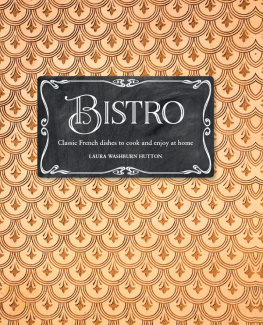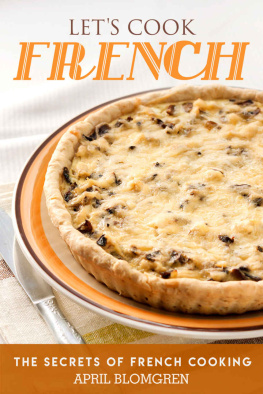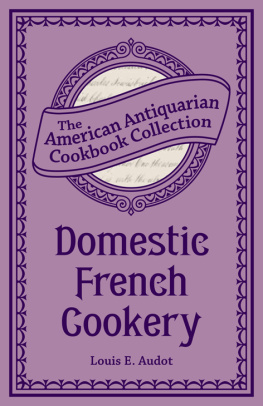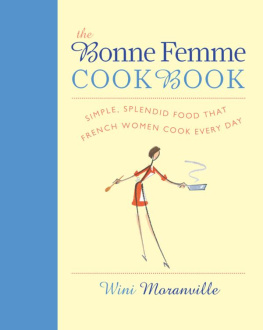French Household Cooking
In the interests of home life, a well-cooked dinner is of more importance than a well-dressed wife. A man will admire a pretty dress, but in time he will get used to the unsatisfactory result of clothes; he never gets tired of good food dressed with care and taste writes the author of French Household Cookery. Frances Keyzer was an Englishwoman who lived in Paris at the beginning of the twentieth century, when French women were reckoned to be the cleverest of cooks, and the Parisians the cleverest of all. Imagination, economy and simplicity were the hallmarks of French domestic cookery, the latter particularly attractive to English women at a time when the lack of servants meant that many women were having to cook themselves for the first time. Feminine independence was also on the rise, producing women of the world with less time to spend in the kitchen. Intended to be an aid to these women, French Household Cookery begins with the elementary rules of good cooking cleanliness, fresh ingredients and good butter and goes on to present a hundred and thirty-seven recipes for well-loved domestic dishes that rely upon the simple methods employed in French homes, where daily meals were always as well prepared as at the most luxurious tables. There are nineteen chapters, beginning with hors-doeuvres and ending with a chapter on menus and recipes from chefs of the best Paris restaurants, including the fabled Ledoyen and Marguerys, where the same emphasis on fresh ingredients, careful cooking and attractive presentation are seen. Men are not the only beneficiaries of good cooking. As the author notes A French philosopher and observer of men and women in the highest classes of society has made a study of the effects of good living upon the fair sex. He concluded that carefully prepared food has been proved to give brilliance to the eyes, freshness to the skin, strength to the muscles and it can safely be said that women who know what to eat are comparatively ten years younger than those who ignore the science.
THE KEGAN PAUL LIBRARY OF CULINARY HISTORY AND COOKERY
All About Ices, Jellies and Creams Henry G. Harris and S. P. Borella
Alexander Dumas Dictionary of Cuisine Alexander Dumas
Something New in Sandwiches M. Redington White
Three Hundred and Sixty-Six Menus and Twelve Hundred Recipes Baron Brisse
A Guide to the Greedy by A Greedy Woman Elizabeth Robins Pennell
Food for the Greedy Nancy Shaw
Home Pickling Henry Sarson
Moorish Recipes John, Fourth Marquis of Bute
The Finer Cooking X. Marcel Boulestin
The Jam Book May Byron
The Modern Cook Charles Elm Francatelli
A Kings Confectioner in the Orient Friedrich linger
Skuses Complete Confectioner E. Skuse
The Gentle Art of Cookery Hilda Leyel and Olga Hartley
Foods Edward Smith
French Household Cooking Frances Keyzer
KEGAN PAUL BOOKS OF RELATED INTEREST
The Anthropologists Cookbook Jessica Kuper
The Complete Book of Turkish Cooking Ayla Esen Algar
History and Culture of Japanese Food Naomichi Ishigi
A Soup for the Qan Paul D. Buell, Eugene N. Anderson and Charles Perry
The Traditional Dietary Culture of Southeast Asia Akira Matsuyama
French Household Cooking
With Recipes from the Best Chefs of Paris
Frances Keyzer
First published 2006 by Kegan Paul
Published 2013 by Routledge
2 Park Square, Milton Park, Abingdon, Oxon OX14 4RN
711 Third Avenue, New York, NY 10017, USA
Routledge is an imprint of the Taylor & Francis Group, an informa business
Kegan Paul, 2006
All Rights reserved. No part of this book may be reprinted or reproduced or utilised in any form or by any electric, mechanical or other means, now known or hereafter invented, including photocopying or recording, or in any information storage or retrieval system, without permission in writing from the publishers.
ISBN 978-0-710-31079-8 (hbk)
British Library Cataloguing in Publication Data
Keyzer, Frances
French household cooking: with recipes from the best chefs of Paris. (Library of culinary arts)
1. Cookery, French
I. Title
641.5944
CONDITIONS to-day have altered the French view of housekeeping. It is a recognised fact that no women on the face of the globe are as clever, where the question of food is concerned, as the French; and, in truth, to put it colloquially, the Parisienne takes the cake.
With the remains of cold meatthe bugbear of the British cookshe makes a succulent stew, where even the most knowing are nonplussed. With a few onions, a couple of tomatoes and a spoonful of curry powder, meat, fish, and fowl are metamorphosed.
Can anything be more useful, at present, than to learn how this is done?
To start with, it is an undisputed fact that feeding has become simpler; and, where at one time a four or five course dinner was considered essential to smartness, to-day, in the best houses, a dish of fish and fowl are all that one requires. Sweets are replaced by cheese and a bowl of fruit.
White table-cloths have almost disappeared in favour of a slip of lace or Chinese embroidery, or even of coloured cloths, and economy is thus effected in the washing bill. The popular dishes are those which require very little butter and no eggs. In this revised edition a chapter on economical dishes has been added, and some useful recipes are included. It cannot be said that the viands have improved in flavour, but they suit the temperament of the hour. A case in point is the making of pancakes without eggs which will be explained in this revised edition.
But a factor in French cooking is, undoubtedly, the patent stewing-pot. It is wonderful in its labour-saving properties and gives the housewife time to attend to the necessary requirements of the household while the dinner cooks itself. This pot is filled with water; beef and bones, carrots, turnips, onions, salt and pepper are added; and, hermetically closed, it can simmer for hours when once brought to boiling-point, without danger of spoiling the contents. A quarter of an hour is said to be all that is necessary to make meat and vegetables palatable, but the well-advised give the quarter of an hour at full speed and leave the saucepan on the corner of the stove for the contents to simmer gently until required.
A broth, a meat course, and a dish of vegetables result.
In old-fashioned families this stewing-pot is taboo because the lid cannot be lifted to scent the flavour; but old-fashioned families are disappearing, and the pot remains.
Celery makes three dishes to-day in the hands of experienced Frenchwomen. They start by extracting the full aroma in soup. Then some of the vegetable is removed, covered with a white sauce, and served as a course. The remaining branches are cut in pieces and mixed with a mayonnaise. The soup and vegetable are served at one meal, the salad at another.
The French cook, in fact, is up-to-date.
THE DAILY MEALS WITHOUT SERVANTS
It is an undisputed fact that we have learnt to do without them, as the song says. In fact, the lack of servants has made women more independent and has brought forth a number of inventions that would have astonished our grandmothers.









